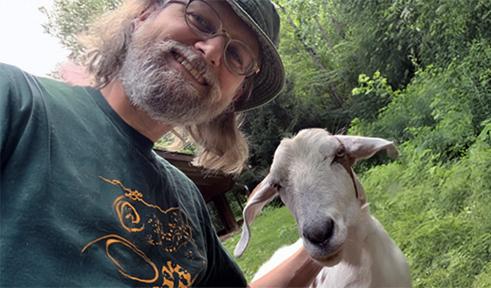Shawn Kuchta

Education
MS, University of Washington
Ph.D., University of California, Berkeley
Biography
I earned my B.S. in Zoology from the University of Washington in Seattle. Raymond Huey was my research adviser. My Ph.D. in Integrative Biology was earned under David Wake in the Museum of Vertebrate Zoology, University of California, Berkeley. After earning my Ph.D., I worked as a postdoctoral scholar at the University of California, Santa Cruz (with Barry Sinervo), Lund University, Sweden (with Erik Svensson), and Dartmouth College (with Ryan Calsbeek). I started my position at Ohio University in the fall of 2010.
Research Interests
I am broadly interested in patterns of diversity and the evolutionary processes that generate, maintain, or limit these patterns. Research is my lab is wide ranging, including species formation, biogeography, adaptation, natural selection, and conservation biology. Our approach is grounded in organismal biology, with a focus on amphibians and reptiles (especially salamanders, but also occasionally damselflies). Our methods include, and often integrate, phylogeography and phylogenetics, genomics, morphometrics, and field ecology.
Publications
Representative Publications
Kuchta, S.R., B.P. Waldron, E.F. Watts, A.R. Lemmon, and E.M. Lemmon. 2024. Population structure and species delimitation in the Wehrle’s salamander complex. Herpetologica 80(2): 165–176.
Waldron, B.P., E.F. Watts, and S.R. Kuchta. 2024. Traversing the Great Lakes region: Post-glacial colonization by a widespread terrestrial salamander. Journal of Biogeography 51(10): 1864-1879.
Watts, E.F., B.P. Waldron, S.R. Kuchta. 2024. Hard edges, soft edges, and species range evolution: A genomic analysis of the Cumberland Plateau salamander. Journal of Biogeography 51(10): 2011-2022.
Waldron, B.P., C.A.Campbell*, and S.R. Kuchta. 2024. Specialist or refugee: Microhabitat use and competition between two sympatric woodland salamanders. Journal of Zoology 323: 45–56 *undergraduate
Kuchta, S.R., M.M. Hantak, B.P. Waldron, C.A. Hickerson, R. Lehtinen, C. Anthony. 2022. Hybridization between the woodland salamanders Plethodon cinereus and P. electromorphus. Ichthyology & Herpetology 110(3): 430-438.
Hantak, M.M.. K.M. Brooks, C.M. Hickerson, C.D. Anthony and S.R. Kuchta. 2020. A spatiotemporal assessment of dietary partitioning between color morphs of a terrestrial salamander. Copeia 108(4): 727-73.
Radomski, T.P., M.M. Hantak, A.D. Brown, and S.R. Kuchta. 2020. Multilocus phylogeography of Eastern Red-backed Salamanders (Plethodon cinereus): cryptic Appalachian diversity and post-glacial range expansion. Herpetologica 76(1): 61-73.
Hantak, M.H., R.B. Page, P.E. Converse, C.D. Anthony, C.M. Hickerson, and S.R. Kuchta. 2019. Do genetic structure and landscape heterogeneity impact color morph frequency in a polymorphic salamander? Ecography 42(8): 1384-1394.
Hantak, M.M. & S.R. Kuchta. 2018. Predator perception across space and time: relative camouflage in a color polymorphic salamander. Biological Journal of the Linnaean Society 123:21-33.
Kuchta, S.R. & D.B. Wake. 2016. Wherefore and whither the ring species? Copeia 104(2): 189-201.
Presentations and Awards
Director, Ohio Center for Ecological and Evolutionary Studies (OCEES)
Rush Elliott Professor of Biological Sciences